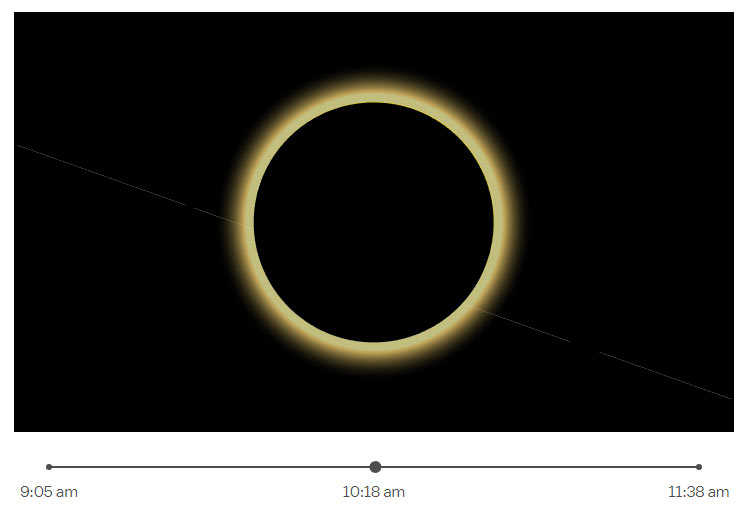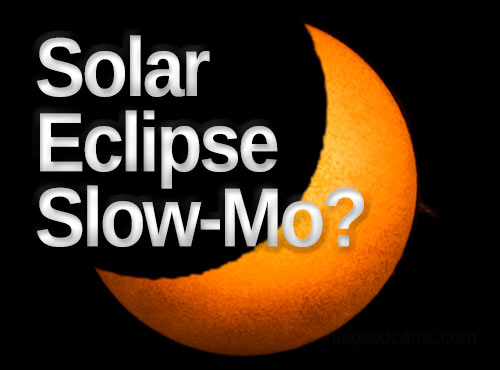We have received quite a few messages about how to shoot the solar eclipse next Monday, August 21st 2017 in slow motion. After all the more frames you capture, the more temporal detail that will be preserved but there is a threshold when diminishing returns from shooting high fps take a toll on image quality, dynamic range and color accuracy.
In short, the rule of shooting the total solar eclipse at high speed will be based on timing on one hand and detail retention on the other. We have found in our research that you really do not need more than 120fps in order to get a great solar corona snapshot with enough detail and variance. 24 and 30fps regular frame rates are also good and perfectly acceptable.
When to shoot?
A totality even during a solar eclipse averages about 2 minutes only. That is the point at which the moon obscures the sun completely and the elusive solar corona is visible to the naked eye and optical instruments. The corona is so dim compared to the regular shine of the sun that it is completely washed out when you point cameras at the fiery orb. The Eclipse is the rare occasion where you are able to see and record the magnetic field of the sun interact with its atmosphere of super heated gas.
2017 Total Solar Eclipse’s Path Across the U.S. by NASA:
So the first part is getting there into the totality path which you can see in red from the NASA animation above. If you are not inside that path you will not experience the full totality of the event, and will only see a partial solar eclipse.
If you do not know when or where exactly the eclipse will be this finder application on the web by VOX will make it very easy to find. Just use your zip code to see if you are covered by it. Below is the Salem Oregon 97301 Zip code shown.

Now that you are ready to watch it and track it, you will need a steady tripod and or ideally an electronic telescope mount. Since totality is only slightly above 2 minutes in duration even a cheap electronic mount will be able to keep the sun centered. You will need to mount your camera and use the appropriate solar filter to frame the sun and not damage your camera sensor. A direct sun shoot can heat up sensor surfaces and cause some damage to the pixel array. Some sensors are better than others at standing the sun’s harmful rays but if you can avoid it by using solar film in the front of your lens. ND and Variable ND filters still allow a lot of infrared light in which can damage the lens.
Note that your eyesight need much more protection for direct viewing. The video below shows 5 ways to look safely at the eclipse.
5 ways to safely view the 2017 total solar eclipse by The Oregonian:
Beware fake solar eclipse safety glasses by CBS News:
Sadly many stores are selling fake or counterfeit solar eclipse glasses. The only way to know for sure they work is if they do not allow you to see anything outside but the sun. The best solar glasses cannot let the light out of a bright led flashlight through at all. They will even block the LED surface itself which can be seen. Most good pairs use a front silver layer and a dark layer on the inside. Farke pairs are mostly black. But you still need to test them.
So what about the Slow Motion?
We recommend you start shooting 30 seconds before totality when you see the diamond ring and stop 30 minutes after when a new diamond ring develops.
- Stay at 120fps or below.
- Use the lowest ISO on the camera, the Sun is already bright; you need to reduce artifacts and increase dynamic range.
- Use the best resolution at your disposal. 30fps 4k will look better than 120fps at 1080p to capture corona detail.
- If you have a 4k camera that can do 60p like the Panasonic GH5 you have the best of both worlds.
- Only remove camera filter once totality is reached. You can burn the camera sensor if you are still in a partial phase.
- Never look at the sun directly to aim the camera, use a sun finder or wear the protective glasses.
- Once totality is reached you will have about 2 minutes to shoot and admire the sun’s corona without protection. Once it is exiting totality wear protection again or stop looking at the sun / cover your camera with a filter or lens cap.
- Never point at the sun with an unprotected camera or telescope and have your eye look through an optical viewfinder or eyepiece. Damage can be amplified 1000x compared to looking normally at the sun.
By shooting in slow motion you can also capture birds and airplanes that traverse the sun’s disk while the eclipse is happening. This is a very interesting take especially in slow motion where you can observe detail from flying objects or wildlife.
Solar Eclipse October 2014 with Jet Airplane HD by Brad Grammer:
ISS solar transit in ultra slow motion (570 FPS) by Bartosz Wojczyński:
If you manage to get a great slow motion clip of the eclipse be sure to share it with us for publication. There is a real lack of slow motion solar eclipse clips out there and it is a special way to record the event that will be important in its own right.
We also ask that you enjoy the event while you let the camera record it. Do not fight the camera or setup while the eclipse totality is happening. set and forget. It is more important for you to witness the Solar Eclipse than for you to record it. It can be a once in a lifetime opportunity. There is another solar eclipse opportunity coming on April 8th, 2024 in North America but it will be the last for many decades. Unless you want to travel to other continents. Have a great time! -HSC
We end this post with an amazing clip of a Solar eclipse in India from the excellent series Wonders of the Solar System by BBC with Brian Cox.
The Solar Eclipse In Varanasi – Wonders of the Solar System Brian Cox by BBC:

